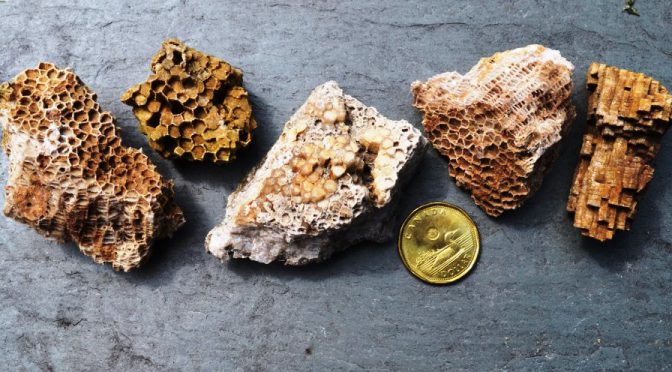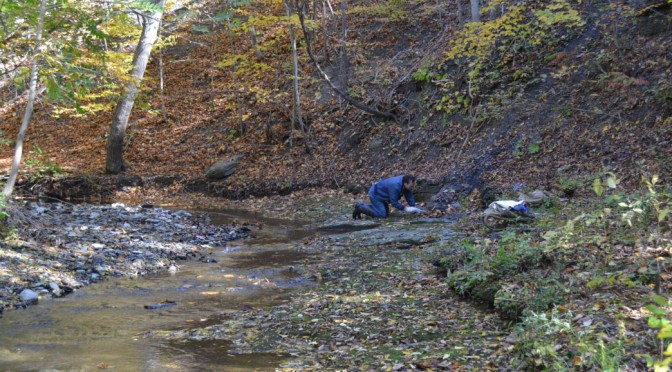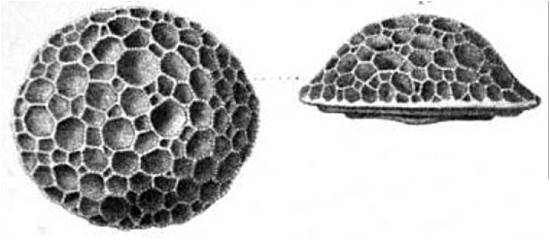Generally, when Wayne County Gem and Mineral Club packs up the buckets, hammers, passports and bug repellent to head north of the border we are after minerals in the Precambrian rocks of the Grenville Geological Province. But recently we have been able to make an annual stop in younger rocks to collect fossils in Ordovician limestones in the Eganville area of eastern Ontario. Specifically we visit the Haley Quarry in Douglas, Ontario and search the Upper Ordovician Verulam and Lindsey Formations of the Ottawa Group. We did so again this year on Wednesday July 19th.
Tag Archives: coral
Indian Creek
There are many well known fossil collecting sites in the creeks and gullies draining into the Finger Lakes (places like Kashong Gully, Deep Run, and Portland Point to name a few). But for every well documented site there are a dozen lesser known locales where drainages into the Finger Lakes expose the fossil rich strata of the 385 million year old Middle Devonian Hamilton Group. Indian Creek, near Williard on the eastern side of Seneca Lake, is one such location.
Pleurodictyum
I have had an active interest in mineral collecting for several decades (five years in Arizona can do that to anyone), but have developed a growing interest in fossils since moving to western New York two years ago. Having completed my first full season of mucking up creeks and stopping at roadcuts in the Silurian and Devonian strata of western New York I can announce that I now have a favorite fossil.
I realize many are, and for very good reason, enamored with trilobites. Be they DiPleura, Greenops, Dalmanites, or Eldredgeops , those are certainly great finds and I will be more than happy to pick one up when I come upon it. But I took a fancy to a simple tabulate coral species this summer: Pleurodictyum americanum, a species first described by the German paleontologist Carl Ferdinand von Roemer in the late 19th century. Note his original drawings in the featured image for this post (Roemer, 1876).
Perhaps it is the near perfect symmetry of the colonial coral that grabbed my eye. With a rounded top and a fairly flat bottom they certainly look grand once clay and shale is washed from the polygonal corallites covering the surface. Even better presentation results when multiple specimens of variable size are displayed together. My interest was also sparked because “pleuros”, as I have come to affectionately call them, are not as common as horn coral or many of the brachiopods species that are ubiquitous at many sites in the Finger Lakes region, but they are also far from rare and when found they are typically complete and recoverable.
Deep Run, Lake Canandaigua
NOTE ADDED OCTOBER 4, 2017: The property in Deep Run has changed ownership and the new owner is NOT allowing collecting or trespassing. The fossil-rich beds described in this note can no longer be visited. WCGMC will not schedule any more trips to Deep Run.
SECOND NOTE December 2019: The creek is still posted No Trespassing, however, the beach is public. In 2019, I started to collect sands and Deep Run Beach was one of my first to collect.
==============================================
Article I wrote for “Site of the Month”, WCGMC News, Sept. 2014
Devonian Fossils at Deep Run
Most residents of western New York carry on their daily business without any knowledge that they live in a region with some of the richest and most diverse fossil collecting in the United States. Those of us in the WCGMC are lucky to know how blessed with are with our collecting opportunities. But do we know the series of geologic events that led to this unique opportunity?
There are other fossil-bearing stratigraphic units in New York, but here we discuss the prolific Middle Devonian Ludlowville Formation within the Hamilton Group. About 385MY ago an inland shallow sea occupied much of western New York and both the sea and the benthic bottom literally teamed with marine life. Corals (both rugose and tabulate), brachiopods, gastropods, crinoids, and, of course, those highly sought after trilobites thrived communally in the shallow seas behind the continental mass to the west and inboard of the Catskill Delta and Acadian Mountains to the east.



